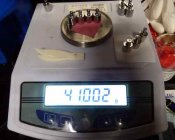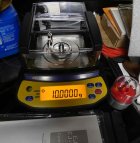I'm a little confused by use of different units, ala references to "count" and "ppm". I noticed your earlier reference to a 300 / ±0.001 gram scale having 300,000 counts. Is this just another way of expressing the overall range and resolution? And how does ppm come into this?Be careful NOT to blame check weight errors on CALIBRATION.
With a good zero, a Full Scale calibration should only be required when conditions change.
Scale moved or temperature changed. For a 50 or 100 gram scale with milligram resolution, error will likely be percentage based. If the cal factor is stable to 20ppm/0.002% per degree F, you will not see it at small loads. Changing position can cause larger errors.
With a good zero, cal @ 100 grams (or 50grams if required).
Let the scale sit at zero for a few minutes to relax the load cell.
Now weigh your cal weight, and suppose it shows 10 counts low,
49.990 (-0.02%) or 99.990 (-0.01%). At smaller loads, like a few grams of powder, that calibration error won't be seen (maybe a count? ). Unless you are OCD like me, don't fret a few counts at heavy load.
Zero, then Fake Zero stability, will matter much more than calibration error.
The 300 gram scale posted can be calibrated @ 200 grams, or 100, 200, 300 grams.
The 3 point cal reduces linearity errors between zero and 100 grams.
Design a check method for YOUR scale with good check weights.
The 1, 11, 111 gram check I did was a fast and easy method of checking Cal factor, linearity, and zero.
And I haven't even tried to understand the temperature factor, but because my shop is so stable I'm not sure it is much of a factor for me.
I had not considered doing anything to check linearity, mostly because I wasn't aware of a way to do it. Looking my scale's manual, I see it does show linearity calibration masses of 50 and 100 grams. There is nothing there, however, about how to do that. I will attempt to find out from Ohaus.
That does bring to mind that I do not know the real world accuracy of the 100 gram standard that came with the unit, and certainly do not know the same for the 10 and 50 gram standards that came with the Hornady scale I have. However, given what you say above about a few counts off at the calibration weight won't really be seen at powder weights (5 to 70 grains in my case), maybe investing in higher accurate weight standards is not really warranted. I have considered taking what I have to a pharmacy or lab to get them weighed on something appropriate, but...
And lastly, I may be a bit confused about when to use the "zero" function. I have been operating under the assumption it should not be used immediately following calibration with the 100 gram weight. My assumption being that doing so changes things inappropriately relative to the calibration. I note with context that it might be appropriate to wait a few minutes with the scale resting at zero following a calibration to let the load cell relax.
Rick



















